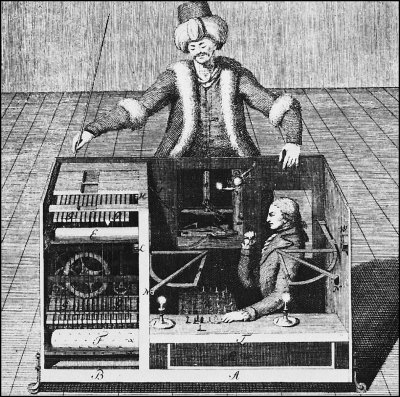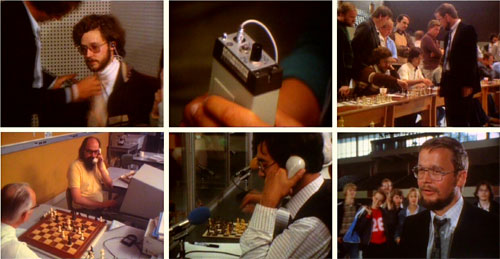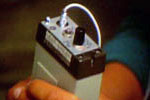Cheating in Chess – Part two
By Frederic Friedel
 Advances in Computer Games 9", edited by Professors H. J. van den Herik, University Maastricht, and B. Monien, University of Paderborn. It was published by the Universiteit Maastricht in 2001. The paper on Cheating was written and submitted by the author in 2000.
Advances in Computer Games 9", edited by Professors H. J. van den Herik, University Maastricht, and B. Monien, University of Paderborn. It was published by the Universiteit Maastricht in 2001. The paper on Cheating was written and submitted by the author in 2000.
Abstract
Nowadays, players at all levels of chess can profit from computer assistance during a game of chess. This is a new development and a serious problem for the game. This contribution lists the main forms of cheating and provides some occurrences from practice. The most prevailing one (Allwermann at the Böblinger Open) is placed in a historical context by describing previously noticed cases of cheating. Finally, the problem of cheating is addressed at the highest level of play. What are the possibilities and how can we prevent cheating at this level? Since there is no clear solution, the problem of cheating remains on the list of issues to be addressed very seriously in the near future.
2. Illegal assistance during the game
Coaching players during the game is probably the most wide-spread form of cheating (rivalled only perhaps by bribery and the throwing of games). Although this practice began long before the advent chess playing machines, it is computers that have added a new and dramatic dimension to this method of cheating in chess.
There are two ways in which cheating can occur with computers involved:
- Human masters influence the moves of the machine so that it plays better than it would normally be able to do.
- A human player will use the assistance of a machine during the game to play better than he would normally be able to do.
In this article we are mainly concerned with the second possibility, although there would be a great deal to say about the first as well, a historic example of which was the famous automaton of Wolfgang von Kempelen.

In the late 18th century this Hungarian nobleman constructed a machine in the form a mechanised Turkish figure. It played chess and beat almost all opponents. Of course it was operated by a human being cleverly hidden within the apparatus.
2.1 First Use of Computers to Cheat
The first time (to the best of my knowledge) that a computer was used to clandestinely help a human player during a game, occurred in Hamburg, Germany, in August 1980. The perpetrators of the deception were the author of this article, a few colleagues from a German TV station, and Ken Thompson of the Bell Laboratories. The victim was German grandmaster Dr Helmut Pfleger.

Unix inventor and pioneer in computer chess: Ken Thompson
At the time we were making a science documentary about computer chess and wanted to perform a chess Turing test of sorts. Dr Pfleger was giving a simultaneous exhibition at the Hamburg Chess Festival, and we decided to secretly play a computer against him. Ken had just finished constructing his new Belle machine. We hid a radio receiver under the hair of a young colleague of mine, Dieter Steinwender, who had a place in the simul. I was able to talk to him from a vantage point high above the tournament hall. Ken was standing by in New Jersey to deliver the moves by phone.

The first special-purpose hardware chess machine Belle
Using a pair of binoculars I followed the moves on Dieter’s board. As soon as the GM made a move I relayed it by phone to Ken, who entered it into the computer. When Helmut approached the board again I would warn Ken, and he would give me Belle’s current best move. This I dictated by radio transmission to Dieter’s earphone, and he executed it as naturally as possible on the board.

Pictures from the original TV production: Steinwender getting the bug, Pfleger at work,
Friedel and Thompson cheating, Pfleger amazed to hear what we had done.
After some hours Helmut Pfleger was winning all his games, including the one against Belle. However, at move 49 he missed a clear way to end it.
Immediately after the game we pointed a camera at Helmut Pfleger and asked him whether he had noticed anything unusual. Nothing. One of the games, we told him, had been played by a machine. Helmut was very surprised. “Which game was that?” He was amazed to hear it was the one he lost. “I really noticed nothing. Wow, these things are really playing quite well these days.”
2.2 The Chess Turing Test
A few days after the event we printed out five of the games that were played in the simultaneous exhibition and sent them to experts all over the world, asking them to identify the computer. Most of the chess experts guessed wrong, most of the computer experts got it right. An exception from the first group was the 17-year-old Garry Kasparov, who was participating in the World Junior Championship in Dortmund. When I showed him the games at the closing dinner he read all five simultaneously from the printout and unerringly identified the computer. All the other games, he explained, contained short-term tactical errors which a computer would never commit.

Garry Kasparov, winner of the World Junior Championship in Dortmund in 1980.
Second was Nigel Short, right, and third Chilean IM Ivan Eduardo Morovic, left.
The Friedel-Thompson-Belle game was of course not strictly an example of cheating. It was an experiment in which the deception was immediately revealed. The same cannot be said about the following examples in which the perpetrators tried to hide their activities as best they could.
2.3 The von Neuman affair
At the World Open 1993 in Philadelphia a completely unknown player appeared, unsubtly calling himself John von Neumann (he was black and had dreadlocks). He played excellently, drawing against GM Helgi Olafsson in the second round. But in round four he suddenly stopped at move nine and lost on time. Here’s the game:
J. von Neumann - D. Shapiro [C44] Philadelphia Open, 1993: 1.e4 e5 2.Nf3 Nc6 3.d4 exd4 4.e5. Very strange move. Maybe von Neumann had missed a black move, e.g. ...Nf6. 4...Nge7 5.Be2 Nf5 6.0-0 Be7 7.Nbd2 0-0 8.Nb3 d6 9.exd6 Qxd6 and now White stopped playing and lost on time. 0-1.
This is how the game from round nine went:
J. von Neumann - NN [B40] Philadelphia Open, 1993: 1.e4 c5 2.Nf3 e6 3.d4 cxd4 4.Nxd4 Nf6 5.Nc3 Bb4 6.e5 Nd5 7.Bd2 Nxc3 8.Bxc3 Bxc3+. Here von Neumann thought for forty minutes, although there is only one reasonable move (pawn takes bishop). Then he disappeared for a while, came back, played 9.bxc3 and won the game. Obviously there was some communication problem that had to be solved.
Von Neumann won a prize in the category of players without an Elo rating. Naturally people had become suspicious of this unknown and highly unorthodox player. Before the organisers handed over the $800 check they asked him to solve a simple chess puzzle. He refused, turned and left, and has never been seen again at chess tournaments.
Addendum
After publishing this installment we got the following message from Denis F Strenzwilk:
I read with interest the article by Frederic Friedel, particularly the section on the game between John von Neuman and Daniel Shapiro. I was playing on the board next to them in round four of the 1993 World Open. My memory of the incident goes like this: I did not know the young black man with dreadlocks. I did not even know that he called himself John von Neuman, as I, a scientist, would have recognized that name. I knew Daniel Shapiro, having played several games against him. I remember the moves of the game differently from what you have recorded. I thought that the first two moves were 1 e4 e5 2 Nf3 Nf6, then somehow von Neuman lost a pawn, made about nine moves, and let his clock run out. Very strange! I talked briefly with Daniel after the game. He told me that there were people who were very interested in what von Neuman was doing. It was the first time I knew something was wrong. In the following weeks and months this affair was written about in chess publications. If you ever get more information on this affair, I hope that you publish it. I have been wondering about this incident since 1993.
– Part three will follow soon –
Previous parts
 |
A history of cheating in chess (1)
29.09.2011 – Hardly a month goes by without some report of cheating in international chess tournaments. The problem has become acute, but it is not new. In 2001 Frederic Friedel contributed a paper to the book "Advances in Computer Chess 9". It traces the many forms of illicit manipulations in chess and, a decade later, appears disconcertingly topical and up-to-date. We reproduce the paper in five parts. |


















 Advances in Computer Games 9", edited by Professors H. J. van den Herik, University Maastricht, and B. Monien, University of Paderborn. It was published by the Universiteit Maastricht in 2001. The paper on Cheating was written and submitted by the author in 2000.
Advances in Computer Games 9", edited by Professors H. J. van den Herik, University Maastricht, and B. Monien, University of Paderborn. It was published by the Universiteit Maastricht in 2001. The paper on Cheating was written and submitted by the author in 2000.










